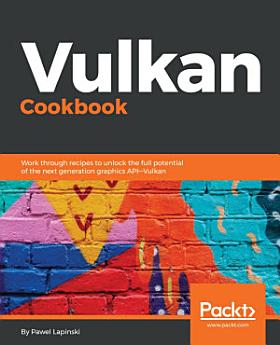Vulkan Cookbook
關於這本電子書
This book is ideal for developers who know C/C++ languages, have some basic familiarity with graphics programming, and now want to take advantage of the new Vulkan API in the process of building next generation computer graphics. Some basic familiarity of Vulkan would be useful to follow the recipes. OpenGL developers who want to take advantage of the Vulkan API will also find this book useful.
What You Will LearnWork with Swapchain to present images on screenCreate, submit, and synchronize operations processed by the hardwareCreate buffers and images, manage their memory, and upload data to them from CPUExplore descriptor sets and set up an interface between application and shadersOrganize drawing operations into a set of render passes and subpassesPrepare graphics pipelines to draw 3D scenes and compute pipelines to perform mathematical calculationsImplement geometry projection and tessellation, texturing, lighting, and post-processing techniquesWrite shaders in GLSL and convert them into SPIR-V assembliesFind out about and implement a collection of popular, advanced rendering techniques found in games and benchmarksIn DetailVulkan is the next generation graphics API released by the Khronos group. It is expected to be the successor to OpenGL and OpenGL ES, which it shares some similarities with such as its cross-platform capabilities, programmed pipeline stages, or nomenclature. Vulkan is a low-level API that gives developers much more control over the hardware, but also adds new responsibilities such as explicit memory and resources management. With it, though, Vulkan is expected to be much faster.
This book is your guide to understanding Vulkan through a series of recipes. We start off by teaching you how to create instances in Vulkan and choose the device on which operations will be performed. You will then explore more complex topics such as command buffers, resources and memory management, pipelines, GLSL shaders, render passes, and more. Gradually, the book moves on to teach you advanced rendering techniques, how to draw 3D scenes, and how to improve the performance of your applications.
By the end of the book, you will be familiar with the latest advanced techniques implemented with the Vulkan API, which can be used on a wide range of platforms.
Style and approachThis recipe-based guide will empower you to implement modern graphic programming techniques and help gain a solid understanding of the new Vulkan API.
評分和評論
關於作者
Pawel Lapinski is a graphics software engineer at Intel Corporation. His professional career started 10 years ago when he and his friends were hired to develop a 3D training/simulation application using C++, OpenGL, and Cg, which was later improved with added head-mounted display support and stereoscopic image generation. Since his studies, Pawel has been interested in 3D graphics and especially in the open multiplatform OpenGL library. He wrote a diploma about the “Effective usage of vertex and fragment shaders.” Since then, he has continued to pursue opportunities to work with 3D graphics and expand his knowledge in the field. He had the opportunity to join a team that was developing one of the biggest CAVE-like installations at the Polish Gdansk University of Technology. His responsibility was to prepare 3D visualizations using Unity3D engine and add stereoscopic image generation and support for motion tracking. Pawel's whole career has involved working with computer graphics, the OpenGL library, and shaders. However, some time ago, already as a programmer at Intel, he had the opportunity to start working with the Vulkan API when he prepared validation tests for the Vulkan graphics driver. He also prepared a series of tutorials teaching people how to use Vulkan and now he wants to share more of his knowledge in the form of a Vulkan Cookbook.




